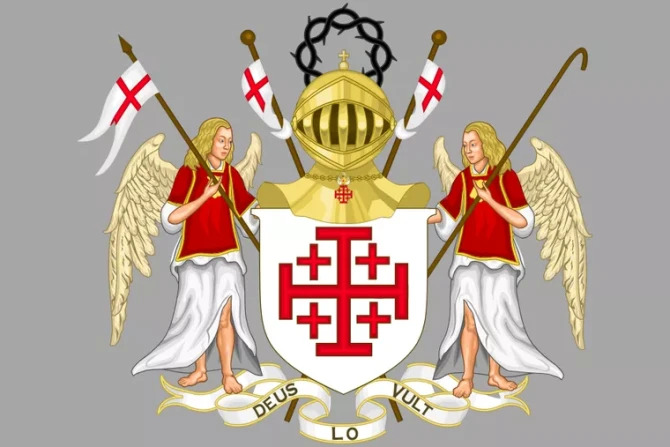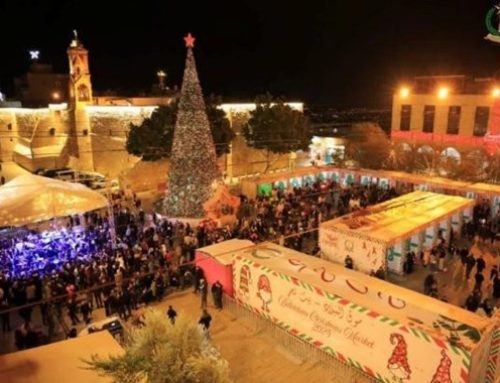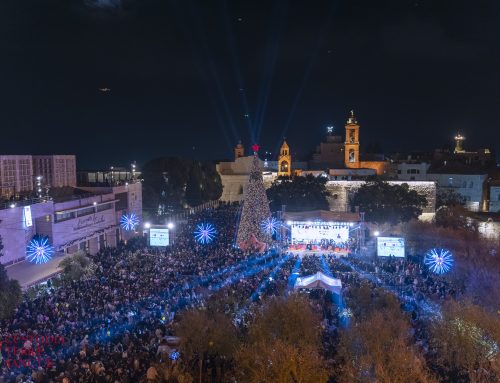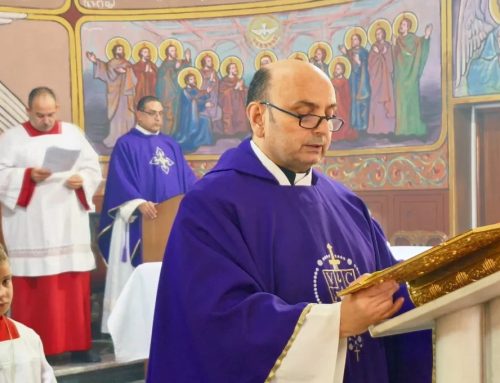The Associated Press recently claimed that President-elect Donald Trump’s nominee to be secretary of defense, Pete Hegseth, had tattoos supposedly connected with Christian nationalism and even white supremacy. It focused especially on the tattoo of a Jerusalem Cross on Hegseth’s upper chest.
The reporting — immediately criticized as anti-Christian by Vice President-elect JD Vance and many others on social media — begs the question: What does the symbol actually mean?
The Jerusalem Cross is one of the most immediately distinguishable Christian symbols anywhere. It comprises a large central cross, called a cross potent, usually with crossbars at the four ends nesting four smaller Greek crosses. It is a deceptively simple design that has now been used for centuries to represent the Church in Jerusalem and to remind the faithful and the world of the Evangelists, Jerusalem, and the suffering of Christ. It is also the heraldic insignia closely associated with the Latin Patriarchate of Jerusalem and especially the Equestrian Order of the Holy Sepulchre of Jerusalem.
A symbol of pilgrimage
The cross first appeared in the years before Pope Blessed Urban II called for the First Crusade (1096–1099) to set off to recapture Jerusalem and the Holy Land from Muslim control. Called at times the Crusader’s Cross, it became attached particularly to the coat of arms of the famed Crusader knight Godfrey de Bouillon, one of the leaders of the First Crusade, but it was not in common use until the latter half of the 13th century when it was adopted as the chief banner of the Kingdom of Jerusalem that ruled over much of the Holy Land until the final expulsion of the Christian knights from the Holy Land in 1291. Even after the end of the Crusader era, pilgrims carried the image of the Jerusalem Cross, connecting their own faith journeys to the passion of Our Lord and the desire to see the Holy City.
The cross has been ubiquitous in Christian imagery ever since. It appears in the artistic and architectural ornamentation of churches and Christian buildings, as a design on Bible covers, and very often as a beautiful piece of jewelry worn to declare one’s Christian faith. The country of Georgia has also used versions of the Jerusalem Cross for its national flag off and on since the early 14th century.
Visitors and pilgrims to Jerusalem will also often receive a tattoo of the cross at the completion of their pilgrimage. This is a tradition that dates back more than 700 years. Perhaps the most famous recipient was in 1862 when Albert, the prince of Wales, the future King Edward VII, received a Jerusalem Cross tattoo on his arm during a visit to the Holy Land. Twenty years later, his two sons, Prince George, duke of York (the future King George V), and Prince Albert Victor, duke of Clarence, also received Jerusalem Cross tattoos while visiting Jerusalem.
Today, the Jerusalem Cross is still the main insignia of the Latin Patriarchate of Jerusalem — the Latin Catholic diocese for the Holy Land — the Custody of the Holy Land run by the Franciscan Order, and the Equestrian Order of the Holy Sepulchre of Jerusalem.
The Order of the Holy Sepulchre is a lay institution and Catholic order of knighthood placed under the protection of the Holy See that has as its main aim to deepen the faith among its members and to support the charitable and social works and institutions of the Church in the Holy Land. The 30,000 worldwide members help build hospitals, schools, clinics, and missions that assist not just Christians but Muslims and Jews and even nonbelievers. In that way, too, the order promotes peace, interreligious harmony, and a future of stability for the Holy Land. Its members are immediately recognized by their cloaks, which are decorated with the red Jerusalem Cross. The official publication of the order’s Rome-based leadership is called The Jerusalem Cross.
The meanings of the Jerusalem Cross
The five elements of the Jerusalem Cross — the cross potent and the four Greek crosses — have been given different spiritual meanings over the centuries, but each reflects the way that the imagery of the cross is focused not on crusades or nationalism but on Christ.
One interpretation is that the five elements represent Christ’s sacrifice on the cross through his five wounds: The smaller crosses depict the wounds on Christ’s feet and hands, and the main cross represents the piercing of his side by the centurion’s spear.
Another version proposes that the four smaller crosses represent the four Evangelists — Matthew, Mark, Luke, and John — while the fifth cross is for Christ. Part of that interpretation is that the four crosses show the way that the Evangelists helped spread the Gospel to the four corners of the world and that we are called to proclaim the faith as well with our minds and hearts focused on the empty tomb in the Church of the Holy Sepulchre in Jerusalem.
Anyone can wear a medallion of the Jerusalem Cross or tattoo themselves with it. But whether we wear it around our necks or place it upon our bodies, we should have as our only purpose to revere and embrace what it represents. Pope Benedict XVI said it well in 2009 when he visited the Holy Sepulchre in Jerusalem:
“This holy place, where God’s power was revealed in weakness and human sufferings were transfigured by divine glory, invites us to look once again with the eyes of faith upon the face of the crucified and risen Lord. Contemplating his glorified flesh, completely transfigured by the Spirit, may we come to realize more fully that even now, through baptism, ‘we bear in our bodies the death of Jesus, that the life of Jesus may be manifested in our own mortal flesh’ (2 Cor 4:10-11). Even now, the grace of the Resurrection is at work within us! May our contemplation of this mystery spur our efforts, both as individuals and as members of the ecclesial community, to grow in the life of the Spirit through conversion, penance, and prayer. May it help us to overcome, by the power of that same Spirit, every conflict and tension born of the flesh, and to remove every obstacle, both within and without, standing in the way of our common witness to Christ and the reconciling power of his love.”






